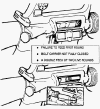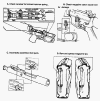Malfunctions are caused by
procedural or mechanical failures of the rifle,
magazine, or ammunition. Pre-firing checks and
serviceability inspections identify potential problems
before they become malfunctions. This paragraph
describes the primary categories of malfunctions.
- Failure to Feed, Chamber, or Lock. A
malfunction can occur when loading the rifle or during
the cycle of operation. Once the magazine has been
loaded into the rifle, the forward movement of the
bolt carrier group could lack enough force (generated
by the expansion of the action spring) to feed,
chamber, or lock the bolt
 . .
Failure to Feed, Chamber or lock
(Click image to
view larger image)
- Probable Causes. The cause could be the
result of one or more of the following:
- Excess accumulation of dirt or fouling in and
around the bolt and bolt carrier.
- Defective magazine (dented, bulged, or a weak
magazine spring).
- Improperly loaded magazine.
- Defective round (projectile forced back into
the cartridge case, which could result in a
stubbed round or the base of the previous
cartridge could be separated, leaving the
remainder in the chamber).
- Damaged or broken action spring.
- Exterior accumulation of dirt in the lower
receiver extension.
- Fouled gas tube resulting in short recoil.
- A magazine resting on the ground or pushed
forward could cause an improper lock.
- Corrective Action. Applying immediate
action usually corrects the malfunction. To avoid
the risk of further jamming, the firer should watch
for ejection of a cartridge and ensure that the
upper receiver is free of any loose rounds. If
immediate action fails to clear the malfunction,
remedial action must be taken. The carrier should
not be forced. If resistance is encountered, which
can occur with an unserviceable round, the bolt
should be locked to the rear, the magazine removed,
and the malfunction cleared. For example, a bolt
override is when a cartridge has wedged itself
between the bolt and charging handle. The best way
to correct this problem is by
- Ensuring the charging handle is pushed forward
and locked in place.
- Securing the rifle and pulling the bolt to the
rear until the bolt seats completely into the
buffer well.
- Turning the rifle upright and allowing the
overridden cartridge to fall out.
- Failure to Fire Cartridge. This is a
failure of a cartridge to fire despite the fact that a
round has been chambered, the trigger pulled, and the
sear released the hammer. This occurs when the firing
pin fails to strike the primer with enough force or
when the ammunition is defective.
- Probable Causes. Excessive carbon buildup
on the firing pin (Figure 3-2, A) is often the
cause, because the full forward travel of the firing
pin is restricted. A defective or worn firing pin
can give the same results. Inspection of the
ammunition could reveal a shallow indentation or no
mark on the primer, indicating a firing pin
malfunction (Figure 3-2, B). Cartridges that show a
normal indentation on the primer, but did not fire
indicate faulty ammunition.

Failure to fire
(Click image to
view larger image)
- Corrective Action. If the malfunction
continues, the firing pin, bolt, carrier, and
locking lug recesses of the barrel extension should
be inspected, and any accumulation of excessive
carbon or fouling should be removed. The firing pin
should also be inspected for damage. Cartridges that
show a normal indentation on the primer, but failed
to fire could indicate a bad
ammunition lot. Those that show a complete
penetration of the primer by the firing pin could
also indicate failure of the cartridge to fully seat
in the chamber.
NOTE: If the round is
suspected to be faulty, it is reported and returned
to the agency responsible for issuing ammunition.
WARNING If an audible “POP”
or reduced recoil occurs during firing, immediately
cease-fire. This POP or reduced recoil could be the
result of a round being fired without enough force
to send the projectile out of the barrel. Do not
apply immediate action. Remove the magazine, lock
the bolt to the rear, and place the selector lever
in the safe position. Visually inspect the bore to
ensure a projectile is not lodged in the barrel. If
a projectile is lodged in the barrel, do not try to
remove it. Turn the rifle in to the armorer.
- Failure to Extract. A failure to extract
results when the cartridge case remains in the chamber
of the rifle. While the bolt and bolt carrier could
move rearward only a short distance, more commonly the
bolt and bolt carrier recoil fully to the rear,
leaving the cartridge case in the chamber. A live
round is then forced into the base of the cartridge
case as the bolt returns in the next feed cycle. This
malfunction is one of the hardest to clear.
WARNING A failure to extract
is considered an extremely serious malfunction,
requiring the use of tools to clear. A live round
could be left in the chamber and accidentally
discharged. If a second live round is fed into the
primer of the chambered live round, the rifle could
explode and cause personal injury. This malfunction
must be properly identified and reported. Failures to
eject should not be reported as extraction failures.
- Probable Cause. Short recoil cycles and
fouled or corroded rifle chambers are the most
common causes of failures to extract. A damaged
extractor or a weak or broken extractor spring can
also cause this malfunction.
- Corrective Action. The severity of a failure to
extract determines the corrective action procedures.
If the bolt has moved rearward far enough to strip a
live round from the magazine in
its forward motion, the bolt and carrier must be
locked to the rear. The magazine and all loose
rounds must be removed before clearing the stoppage.
Usually, tapping the butt of the rifle on a hard
surface causes the cartridge to fall out of the
chamber. However, if the cartridge case is ruptured,
it can be seized. When this occurs, a cleaning rod
can be inserted into the bore from the muzzle end.
The cartridge case can be forced from the chamber by
tapping the cleaning rod against the inside base of
the fired cartridge. If cleaning and inspecting the
mechanism and chamber reveals no defects but
failures to extract persist, the extractor and
extractor spring should be replaced. If the chamber
surface is damaged, the entire barrel must be
replaced.
- Failure to Eject. Ejection of a cartridge
is an element in the cycle of functioning of the
rifle, regardless of the mode of fire. A malfunction
occurs when the cartridge is not ejected through the
ejection port and either remains partly in the chamber
or becomes jammed in the upper receiver as the bolt
closes. When the firer initially clears the rifle, the
cartridge could strike an inside surface of the
receiver and bounce back into the path of the bolt.
- Probable Cause. The cartridge must
extract before it can eject. Failures to eject can
also be caused by a buildup of carbon or fouling on
the ejector spring or extractor, or from short
recoil. Short recoil is usually due to a buildup of
fouling in the carrier mechanism or gas tube, which
could result in many failures to include a failure
to eject. Resistance caused by a carbon-coated or
corroded chamber can impede the extraction, and then
the ejection of a cartridge.
- Corrective Action. While retraction of
the charging handle usually frees the cartridge and
permits removal, the charging handle must not be
released until the position of the next live round
is determined. If another live round has been
sufficiently stripped from the magazine or remains
in the chamber, then the magazine and all live
rounds could also require removal before the
charging handle can be released. If several
malfunctions occur and are not corrected by cleaning
and lubricating, the ejector spring, extractor
spring, and extractor should be replaced.
- Other Malfunctions.
The following
paragraphs describe some other malfunctions that can
occur.
- The bolt fails to remain in a rearward position
after the last round in the magazine is fired. Check
for a bad magazine or short recoil.
- The bolt fails to lock in the rearward position
when the bolt catch has been engaged. Check bolt
catch; turn in to unit armorer.
- The weapon fires two or more rounds when the
trigger is pulled and the selection lever is in the
SEMI position. This indicates a worn sear, cam, or
disconnector. Turn in to armorer to repair and
replace trigger group parts as required.
- The trigger fails to pull or return after
release with the selector set in a firing position.
This indicates that the trigger pin has backed out
of the receiver or the hammer spring is broken. Turn
in to armorer to replace or repair.
- The magazine fails to lock into the magazine
well. Check the magazine and magazine catch for
damage. Turn in to armorer to adjust the catch;
replace as required.
- Any part of the bolt carrier group fails to
function. Check for incorrect assembly of
components. Correctly clean and assemble the bolt
carrier group, or replace damaged parts.
- The ammunition fails to feed from the magazine.
Check for damaged magazine. A damaged magazine could
cause repeated feeding failures and should be turned
in to the armorer or exchanged.
NOTE: Additional technical information on
troubleshooting malfunctions and replacing components is
contained in the organizational and direct support
maintenance publications and manuals

Other Possible Malfunctions
(Click image to view larger image)
|